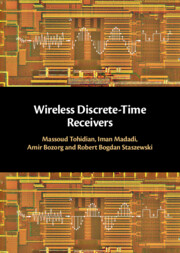4 - Discrete-Time Band-Pass Filter
Published online by Cambridge University Press: 05 May 2022
Summary
A complex quadrature charge-sharing (CS) technique is utilized to implement a discrete-time band-pass filter with a programmable bandwidth of 20–100 MHz. The BPF is a natural part of a cellular superheterodyne receiver and completely determines the receiver frequency selectivity. It operates at the full sampling rate (4×) (described in Chapter 2 of up to 5.2 GHz corresponding to the 1.2 GHz RF input frequency, thus making it free from any aliasing or replicas in its transfer function. Furthermore, the advantages of CS-BPFover other band-pass filters, such as N-path, active-RC, Gm-C, and biquad are described. A mathematical noise analysis of the CS-BPF and the comparison of simulations and calculations are presented. The entire 65 nm CMOS receiver, which does not include a front-end LNTA for test reasons, achieves a total gain of 35 dB, IRN of 1.5 nV/?Hz, out-of-band IIP3 of +10 dBm. It consumes 24 mA at 1.2 V power supply.
- Type
- Chapter
- Information
- Wireless Discrete-Time Receivers , pp. 87 - 106Publisher: Cambridge University PressPrint publication year: 2022



